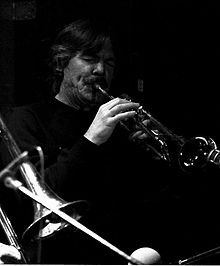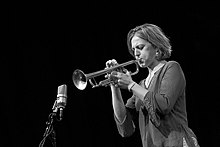Jazz trumpet
Jazz trumpet is a specific design of the trumpet . The term also names the role of the trumpet in jazz .
Classical trumpeters mostly use the concert trumpet with rotary valves , especially in German-speaking countries . Most jazz trumpet players, on the other hand, use the jazz trumpet with its pump valves, which go back to François Périnet in its current form , as this instrument better supports jazz-specific playing techniques. The pocket trumpet is also occasionally used (e.g. by Don Cherry or Mongezi Feza ). In addition to the trumpet, related instruments are often used in jazz, in particular the cornet , the flugelhorn and (more rarely) the slide trumpet .
Louis Armstrong and Bix Beiderbecke are the protagonists on the jazz trumpet or the cornet for oldtime jazz . The central trumpeters for bop and modern jazz are Dizzy Gillespie and Miles Davis .

The origins and lines of tradition of the jazz trumpet
The trumpet in traditional jazz
The jazz style was developed on the cornet; the great "trumpeters" of New Orleans jazz were all cornetists, such as Wild Bill Davison (1906–1989), Muggsy Spanier (1906–1967) and finally Rex Stewart (1907–1967). It is unclear why Joachim-Ernst Berendt described the trumpet as the main instrument in jazz in the first edition of Das Jazzbuch (1953).
The first generation of jazz cornetists included the legendary Buddy Bolden (1877–1931), Freddie Keppard (1890–1933), Manuel Perez (1879–1946), Bunk Johnson (1889–1949 - his first recordings were not made until 1942), Papa Celestin (1884-1954), Natty Dominique (1896-1982), Tommy Ladnier (1900-1939) and King Oliver (1885-1938).
Louis Armstrong (1901–1971), who (according to Digby Fairweather ) with Bix Beiderbecke probably the most influential musician of the classical era, then put the trumpet in place of the cornet in 1928. In 1929 Jack Purvis recorded his "Copyin 'Louis", which consisted of lots of set pieces by Armstrong.
Berendt mentions that of the white trumpeters as another line of tradition, beginning with Nick LaRocca (1889–1961), the founding member of the Original Dixieland Jass Band , then Sharkey Bonano (1904–1972) and Muggsy Spanier. LaRocca and Bonano were role models for Bix Beiderbecke (1903–1931), who died early ; these include Bunny Berigan (1908–1942), Jimmy McPartland (1907–1991), Bobby Hackett (1915–1976) and band leader Harry James (1916–1983).
Ellington's Trumpeter and the Swing
Berendt mentions the Ellington trumpeters among the early jazz trumpeters , the masters of the jungle style who introduced the growl effect. The first of these jungle cornet players was Bubber Miley (1903-1932), one of the most important musicians of the early Ellington Orchestra in the 1920s. Bubber was heavily influenced by King Oliver ; his solo in Black and Tan Fantasy from 1927, which he had co-composed, was famous . Miley's successors were Arthur Whetsol (1905–1940), Rex Stewart and Cootie Williams (1911–1985); whose main titles in the Ellington Band were Echoes of Harlem and Concerto for Cootie . The Ellington musicians' growl style influenced u. a. Sidney De Paris (1905–1967), Max Kaminsky (1908–1994) and, last but not least, Hot Lips Page (1908–1954), who, alongside Armstrong, was considered the most important trumpeter of the 1930s. Henry Red Allen (1908–1967), who already deviated from the New Orleans style, was valued more by his fellow musicians than by the public. The game of Roy Eldridge (1911–1989), Buck Clayton (1911–1991), Harry Sweets Edison (1915–1999) and Charlie Shavers (1917–1971) showed more modern tendencies ; Sweets and Buck were among the great soloists in the Count Basie Orchestra; their traditions and a. by Ruby Braff (1917–2003) and Warren Vaché . Charlie Shavers, in turn, was the role model for Maynard Ferguson (1928-2006), who became known in the Stan Kenton Band, and later for Arturo Sandoval , with his high notes . Other important swing trumpeters were Billy Butterfield and Johnny Best .
Berendt highlighted the pioneering work of swing trumpeters - especially by Eldridge - which then affected the bebop trumpet players , such as Dizzy Gillespie (1917-1993) and Fats Navarro (1923-1950). Even Howard McGhee (1918-1987) and Miles Davis (1926-1991) was influenced by Gillespie. In 1953 Berendt believed that Davis was the musician who would show the jazz trumpet its way: long, sweeping melodic arcs, even less vibrato than Dizzy.
Miles Davis / Hardbop / Cool
With Miles Davis , who started his career in Charlie Parker's band in 1945, the second phase of the modern jazz trumpet after Dizzy Gillespie began, according to Berendt in 1991: This is how the development of the jazz trumpet takes place in the contradiction between Dizzy and Miles, as well as the influence of Navarro whose place later Clifford Brown (1930-1956) stepped. Chet Baker (1929–1988), Johnny Coles (1926–1997) and Art Farmer (1928–1999) are closer to Miles; the hardbop trumpeters are more related to the vitality of bebop; Donald Byrd , Thad Jones , Lee Morgan , Bill Hardman , Nat Adderley , Ira Sullivan , Ted Curson , Blue Mitchell , Booker Little and finally Freddie Hubbard (1938–2008) and Woody Shaw (1944–1989) are trumpeters in this direction. Hubbard is considered to be one of the most glamorous trumpeters of a generation that has one foot in the hard bop camp and the other in the fusion camp. Woody Shaw integrated the influences of modal jazz into the bop. In the early 1980s he had a formation whose frontline consisted only of brass; only trumpet and trombone , played by Steve Turre ( The Moontrane ).
Neo-bop
In neobop, the bop game flowed together with the stream of modal jazz, whereby the overriding influence of John Coltrane becomes clear; Musicians like Jack Walrath , Jon Faddis , Franco Ambrosetti , Lew Soloff , Hannibal Marvin Peterson , Terumasa Hino and Randy Brecker are trumpeters in this direction. Musicians of the new traditionalism around Wynton Marsalis continued this development; these include Terence Blanchard , Wallace Roney , Philip Harper , Roy Hargrove , Brian Lynch and Tom Harrell , who reassess the jazz tradition - sometimes in an eclectic way - from the light of bop. Wynton Marsalis (* 1961) took a prominent position in this movement; While his beginnings were dominated by the great hard bop trumpeters such as Clifford Brown, Lee Morgan and Freddie Hubbard, he later succeeded in breaking free of hard bop from its limited formula canon. Marsalis justified his approach as follows: "Before you understand what the extension of a thing is, you have to understand what this thing actually is".

Free game / Don Cherry
Don Cherry (1936–1995), who began his career as a member of the Ornette Coleman Quartet, is known as the “poet of free jazz ”, with a game of great, intimate, luminous expressiveness. With his numerous projects in Europe, such as the band Codona, he became an exponent of world music ; After Berendt, all other free jazz trumpeters are in the shadow of Cherry, such as Lester Bowie (1940–1999), trumpeter in the Art Ensemble of Chicago , Bobby Bradford (* 1934), Wadada Leo Smith (* 1941), Lawrence Butch Morris (1947– 2013), Don Ellis (1934–1978), Toshinori Kondō and Michael Mantler (* 1947).
Bowie's achievements in particular shaped the generation of American musicians of the 1980s; Olu Dara , Baikida Carroll , Herb Robertson , Rasul Siddik , Stanton Davis , Paul Smoker should be mentioned here. Starting from the foundation of free jazz , a number of European trumpeters have also developed their own playing since the 1960s; the most important are Kenny Wheeler (* 1930), Harry Beckett (1935-2010), Ian Carr , Palle Mikkelborg , Enrico Rava (* 1943), Paolo Fresu (* 1961), Tomasz Stańko (* 1942), and Manfred Schoof (* 1936), Herbert Joos (1940–2019), Reiner Winterschladen , Axel Dörner and Matthias Schriefl in Germany.
Jazz-specific playing techniques

Jazz musicians often use techniques when playing the trumpet that are not taught in classical training. These include in particular:
- false fingering , d. H. unusual handle combinations such as B. Valve 1 + 3 for g1 and d2 (instead of without valve and valve 1). This technique was generally used by Bix Beiderbecke in particular,but also occasionally, for example, by Louis Armstrong ( Potato Head Blues )
- Growl , expressive tones combined from a certain tongue technique with the movement of a plunger damper in front of the bell. Bubber Miley and Cootie Williams in particular were known for this style of play.
- screaming , playing extremely high notes in the note range g '' 'to g' '' '. This difficult technique can be found, for example, with Cat Anderson , Maynard Ferguson or Arturo Sandoval .
- shake , also incorrectly called "lip trill", which is created by moving the back of the tongue up and down
- bend , the slipping of the sound
- smear , the "smearing" of the sound by only partially pressing the valves
Jazz and classical trumpeters
The early jazz trumpeters were predominantly self-taught , they usually did not have a classically sound training. Today most of the performers have graduated from a music school and / or a conservatory ; often they do not limit themselves to playing jazz music. A division into jazz trumpeters and non-jazz trumpeters is becoming increasingly questionable.
literature
- Joachim-Ernst Berendt: The Jazz Book . Fischer library, Frankfurt / M. 1953; Krüger, Frankfurt / M. 1976
- Joachim-Ernst Berendt, Günther Huesmann: The jazz book . Fischer TB, Frankfurt / M. 1994
- Ian Carr , Digby Fairweather , Brian Priestley : Rough Guide Jazz. The ultimate guide to jazz. 1800 bands and artists from the beginning until today. 2nd, expanded and updated edition. Metzler, Stuttgart / Weimar 2004, ISBN 3-476-01892-X .
- Richard Cook , Brian Morton : The Penguin Guide to Jazz on CD . 6th edition. Penguin, London 2002, ISBN 0-14-051521-6 .
- Martin Kunzler : Jazz Lexicon . Rowohlt, Reinbek 1988
Web links
- Dan Miller: History of the Jazz Trumpet
References and comments
- ↑ Berendt saw - in the first edition of his jazz book 1953, later he revised this point of view - the Beiderbecke legacy extended to bebop and cool jazz ; especially the smooth and melodious solos of the early Miles Davis (1926–1991) sound as if Beiderbecke's Chicago style had simply been transformed into cool jazz. See Berendt, 1953, p. 122.
- ↑ cf. Berendt / Huesmann, S, 266.
- ↑ cit. to. Berendt / Hesmann, p. 196 f.
